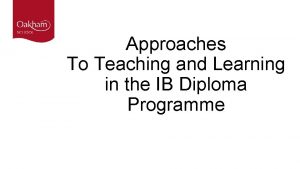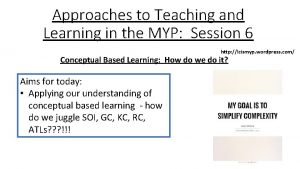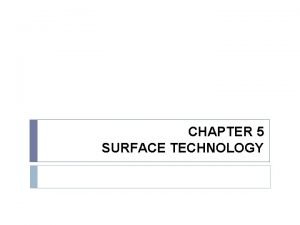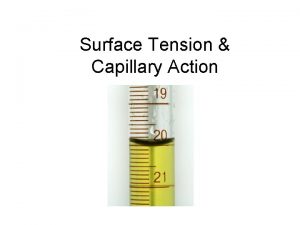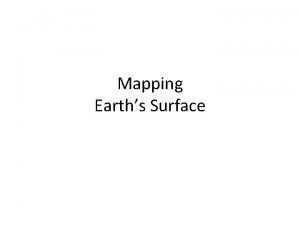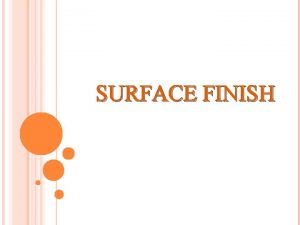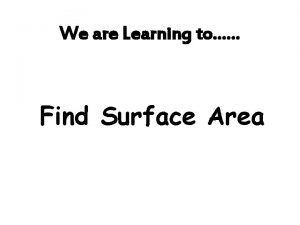Learning Approaches Approaches to learning n Surface approach












- Slides: 12

Learning Approaches

Approaches to learning n Surface approach – Extrinsic motivation to learn (I’ve got to learn to pass the in-service exam) n Deep approach – Intrinsic motivation to learn – learning to understand n Strategic approach – Whatever it takes to get high grades Marton & Saljo, 1997

How can we motivate a Deep Approach to Learning? Provide background knowledge of the subject. – Assimilation - Teach basic sciences in the context of patient cases (Anchor learning activities to a larger problem) – Accommodation - Have learner compare and contrast the history in a case of abdominal pain, with historical findings that he/she already has learnt about e. g. findings for appendicitis vs. PID (Design learning experience to add new information to previous knowledge) – Transfer - Given a patient with abdominal pain in the ER, learner can apply previous knowledge, to diagnose whether patient has appendicitis or PID or something else (Give an example of how the learning can be used in another situation)

How can we motivate a Deep Approach to Learning? (cont: ) n State desired outcomes/goals clearly – Attend and successfully complete course work directed at analyzing, interpreting, and discussing the current periodontal literature recently published in refereed journals. – Be able to admit a patient and perform a complete history and physical examination. – Be able to write up the admission history and physical examination. – Be able to design the best initial treatment for the patient at either patient’s home, clinic, or hospital.

How can we motivate a Deep Approach to Learning? (cont: ) n Provide timely and informative feedback – Immediate or soon after the learning – Objective description of behaviors – Progress of learning Use active teaching methods which engage learners n Be stimulating, enthusiastic and caring n – Caring on conceptual level – Caring at personal level

How can we motivate a Deep Approach to Learning? (cont: ) n Provide freedom of choice over learning content and method – Visual, auditory n Have appropriate workload – Overloaded curriculum = surface learning n Use assessment methods that emphasize conceptual understanding

How can we motivate a Deep Approach to Learning? (cont: ) Use assessment methods that emphasize conceptual understanding at the basic science level n A 32 -year-old woman with type 1 diabetes mellitus had progressive renal failure over the past 2 years. She has not yet started dialysis. Examination shows no abnormalities. Her hemoglobin concentration is 9 g/d. L, hematocrit is 28%, and mean corpuscular volume is 94 µm 3. A blood smear shows normochromic, normocytic cells. Which of the following is the most likely cause? A. Acute blood loss B. Chronic lymphocytic leukemia C. Erythrocyte enzyme deficiency D. Erythropoietin deficiency E. Immunohemolysis F. Microangiopathic hemolysis G. Polycythemia vera

How can we motivate a Deep Approach to Learning? (cont: ) Use assessment methods that emphasize conceptual understanding for making a working diagnosis. (A) (B) (C) (D) (E) Over the past week, a 55 -year-old woman has had extreme dizziness on lying down and getting up. She says it feels as though the room is spinning. Examination shows no abnormalities except for fatigable nystagmus toward the left when the patient is lying on her left side. Which of the following is the most likely diagnosis? Benign positional vertigo Meniere disease Perilymphatic fistula Tumor of the glomus jugulare Vestibular neuronitis

How can we motivate a Deep Approach to Learning? (cont: ) Use assessment methods that emphasize conceptual understanding (at the management level) A 12 -month-old boy is brought to the office by his mother for his routine health check -up. She informs you that she has just been diagnosed with hypercholesterolemia. Her fasting serum total cholesterol concentration was 260 mg/d. L and her LDL-cholesterol concentration was 130 mg/d. L (rec<129 mg/d. L). She is unaware of a family history of coronary artery disease because she was raised by her godmother when her parents died in their early 30 s in a motor vehicle accident. A special diet has been recommended for her; however, she is very concerned about the risk of hypercholesterolemia for her son. Which of the following is the most appropriate management at this time? (A) Ask her to reduce the child's fat intake and give him skim milk instead of whole milk (B) Do nothing until the child is 2 years of age (C) Have the child return for a fasting lipoprotein analysis (D) Obtain a random serum total cholesterol concentration for the child today (E) Refer the child to a lipid specialist

Learning environments to promote a deep approach n Problem-based learning n Use explicit learning objectives n Align assessment to learning objectives n Formal self-appraisal

Learning environments to promote a deep approach n Problem-based learning – – – Present learners with a problem to solve Hypothesis generation Inquiry Data analysis Problem synthesis Commitment as to cause of problem

Learning environments to promote a deep approach Provide explicit learning objectives n Align assessment methods to learning objectives n – Problem solving - Patient management problem – Collaborative learning - Group project – Critical thinking - Research paper analysis n Formal self-appraisal – For an assignment, provide a list of criteria to judge the assignment. – Have each student judge the assignment himself/herself – Compare it with faculty’s judgment
 Tony wagner's seven survival skills
Tony wagner's seven survival skills Total surface area of triangle
Total surface area of triangle Spin coat
Spin coat Curved surface area of cone
Curved surface area of cone Virtual circuit vs datagram
Virtual circuit vs datagram Cognitive approach vs behavioral approach
Cognitive approach vs behavioral approach Waterfall strategy
Waterfall strategy Multiple approach-avoidance conflict
Multiple approach-avoidance conflict Cognitive approach vs behavioral approach
Cognitive approach vs behavioral approach What is research approach definition
What is research approach definition Traditional approach in system analysis and design
Traditional approach in system analysis and design Ib approaches to teaching
Ib approaches to teaching Platon managebac
Platon managebac











